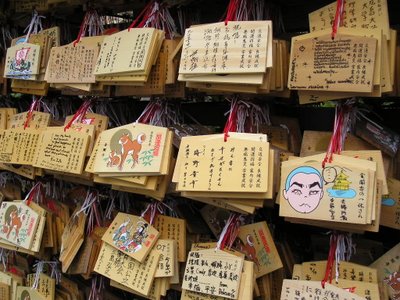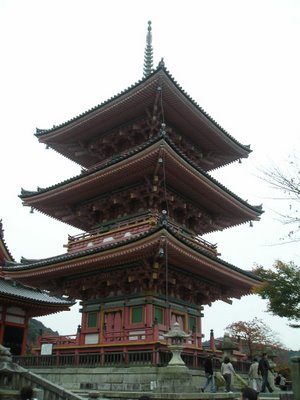It’s been said that if you have been to Japan but have not been to Kyoto, then you have not seen Japan. I would agree with this. Kyoto is an old city rich with history and cultural treasures having been Japan’s capital and the emperor’s residence from 794 until 1868. Its value and importance is illustrated in its having been spared by the Americans from their air raids and fire bombing during the war. For me therefore, its Kyoto or nothing.
After some days of hesitation, I finally traveled to Kyoto one weekend with a Lao friend, Posy-san, who was on his way to visit Kobe. Ogino-san advised me to take the shinkansen with a travel time of only 45 minutes but I decided that it’s too expensive for me. We instead took the Limited Express train (i.e. ordinary train with limited stops) for a 2-hour trip with a changing of train midway at Maibara Station. Ogino-san recommended that I visit the Kinkakuji and Kiyomizudera Temples, and the Nijo Castle. I said I will and also included Ryoanji Temple because it’s is also a UNESCO World Heritage Site like the first three. This is my recommended Kyoto Protocol for 1 day tourists like me.
In Kyoto, I bought a 1-day bus pass for Y500 that will take me to any point within the city limits which is a bargain because the minimum 1-way fare is Y200. First stop is the Kinkakuji Temple/Rokuon-ji Temple or the Golden Pavilion that has existed since 1220 as the home of Kintsune Saionji. In 1397, Ashikaga Yoshimitsu started rebuilding the place as his residence 3 years after abdicating as the 3rd Shogun of Ashikaga. He was a Zen Buddhist --- the most popular sect among the samurai class during that time --- and seek enlightenment through meditation and discipline. Thus, he tried to make his compound as sedatingly serene as possible. When he died in 1408, Kinkakuji/Rokuon-ji was converted into a Zen temple as he willed. The pavilion was covered with gold leafs and houses sacred Buddha relics. It was burned down by a fanatic monk in 1950 and rebuilt five years later.



A 15-minute walk from the Golden Pavilion is another Zen shrine --- the Ryoanji Temple. It is famous for its rock garden, said to have been made by Soami at around 1500. Rock gardens are meditation mediums for Zen Buddhism. That of Ryoanji is made up of 15 rocks, white gravel, and enclosed in a wall made of clay that was boiled in oil. It belongs to the Karensansui Garden category of Japanese gardens that features a reproduction of natural landscapes in an abstract way. The other Japanese garden categories are the Tsukiyama Garden category which is basically the creation of artificial hills, and the Chaniwa Garden category that is specially laid-out for tea ceremonies. Outside the Kuri or main temple building is the aesthetically stunning Kyoyochi Pond that was built in the 12th century.



Next stop will be the Nijo Castle that was erected in 1603 by this blog’s most famous Japanese --- Tokugawa Ieyasu --- as his and his successors’ official residence. The castle actually has 2 palaces with Ninomaru Palace, declared as a Japanese National Treasure, as the most important. It was built of Hinoki or Japanese cypress wood and is renowned for its Momoyama architecture, sliding doors, and squeaking Uguisu-Bari or nightingale floors that warned of intruders. Within the inner moat and enclosed by the breathtaking Ninomaru and Seiryu-en Gardens is the Honmaru Palace that was built in 1626 from structures taken from the Fushimi Castle. It burned down in 1750 and was rebuilt in 1893 from components taken from the Kyoto Imperial Palace.



The highlight of the Kyoto Protocol is a late afternoon pilgrimage at the Kiyomazudera or Pure Water Temple. It was founded in 780 and is said to be one of Japan’s most celebrated temple. Aside from its huge wooden main hall, the temple also features the Sishu Shrine that is dedicated to the god of love, a spring below the main hall’s terrace that is said to have healing powers, and a very dark chamber where I groped my towards a stone relic that is said to make those who touched it very happy. I was tired and hungry after a long day walking but indeed a very happy person who slept my way back to Nagoya afterwards.



PHOTOS (top to bottom):
1) The Golden Pavilion’s elegance radiate from the still waters of the Kyoko-chi or Mirror Pond.
2-3) Dreams and wishes were asked from heaven in writing and through candles (my 2 candles for my family’s good health, long life, and prosperity) at the Golden Pavilion’s fudo-do or hall for the Fire God Fudo-do.
4) Ryoanji Temple’s famous rock garden.
5) The 900-year old Kyoyochi Pond outside Ryoanji Temple’s Kuri or main building.
6) The inscription on the Tsukubai or the tearoom’s stone washbasin read “I learn only to be contented”. It was said to be a gift to the Ryoanji Temple from Mitsukuni Tokugawa (1628-1700) who compiled the Dai Nippon-shi or “The Great History of Japan”.
7) Japanese tourists in their traditional Kimono dress take pictures outside Nijo Castle’s Ninomaru Palace.
8) A panoramic view of the Honmaru Castle.
9) Nijo Castle’s traditional teahouse.
10) The pagoda of the Kiyomazudera Temple.
11) Kiyomazudera Temple’s main hall. The healing spring is under the terrace while the “dark chamber” is under one of the temple’s minor halls.
12) Buddha stone images outside Kiyomazudera Temple’s main hall.
After some days of hesitation, I finally traveled to Kyoto one weekend with a Lao friend, Posy-san, who was on his way to visit Kobe. Ogino-san advised me to take the shinkansen with a travel time of only 45 minutes but I decided that it’s too expensive for me. We instead took the Limited Express train (i.e. ordinary train with limited stops) for a 2-hour trip with a changing of train midway at Maibara Station. Ogino-san recommended that I visit the Kinkakuji and Kiyomizudera Temples, and the Nijo Castle. I said I will and also included Ryoanji Temple because it’s is also a UNESCO World Heritage Site like the first three. This is my recommended Kyoto Protocol for 1 day tourists like me.
In Kyoto, I bought a 1-day bus pass for Y500 that will take me to any point within the city limits which is a bargain because the minimum 1-way fare is Y200. First stop is the Kinkakuji Temple/Rokuon-ji Temple or the Golden Pavilion that has existed since 1220 as the home of Kintsune Saionji. In 1397, Ashikaga Yoshimitsu started rebuilding the place as his residence 3 years after abdicating as the 3rd Shogun of Ashikaga. He was a Zen Buddhist --- the most popular sect among the samurai class during that time --- and seek enlightenment through meditation and discipline. Thus, he tried to make his compound as sedatingly serene as possible. When he died in 1408, Kinkakuji/Rokuon-ji was converted into a Zen temple as he willed. The pavilion was covered with gold leafs and houses sacred Buddha relics. It was burned down by a fanatic monk in 1950 and rebuilt five years later.



A 15-minute walk from the Golden Pavilion is another Zen shrine --- the Ryoanji Temple. It is famous for its rock garden, said to have been made by Soami at around 1500. Rock gardens are meditation mediums for Zen Buddhism. That of Ryoanji is made up of 15 rocks, white gravel, and enclosed in a wall made of clay that was boiled in oil. It belongs to the Karensansui Garden category of Japanese gardens that features a reproduction of natural landscapes in an abstract way. The other Japanese garden categories are the Tsukiyama Garden category which is basically the creation of artificial hills, and the Chaniwa Garden category that is specially laid-out for tea ceremonies. Outside the Kuri or main temple building is the aesthetically stunning Kyoyochi Pond that was built in the 12th century.



Next stop will be the Nijo Castle that was erected in 1603 by this blog’s most famous Japanese --- Tokugawa Ieyasu --- as his and his successors’ official residence. The castle actually has 2 palaces with Ninomaru Palace, declared as a Japanese National Treasure, as the most important. It was built of Hinoki or Japanese cypress wood and is renowned for its Momoyama architecture, sliding doors, and squeaking Uguisu-Bari or nightingale floors that warned of intruders. Within the inner moat and enclosed by the breathtaking Ninomaru and Seiryu-en Gardens is the Honmaru Palace that was built in 1626 from structures taken from the Fushimi Castle. It burned down in 1750 and was rebuilt in 1893 from components taken from the Kyoto Imperial Palace.



The highlight of the Kyoto Protocol is a late afternoon pilgrimage at the Kiyomazudera or Pure Water Temple. It was founded in 780 and is said to be one of Japan’s most celebrated temple. Aside from its huge wooden main hall, the temple also features the Sishu Shrine that is dedicated to the god of love, a spring below the main hall’s terrace that is said to have healing powers, and a very dark chamber where I groped my towards a stone relic that is said to make those who touched it very happy. I was tired and hungry after a long day walking but indeed a very happy person who slept my way back to Nagoya afterwards.



PHOTOS (top to bottom):
1) The Golden Pavilion’s elegance radiate from the still waters of the Kyoko-chi or Mirror Pond.
2-3) Dreams and wishes were asked from heaven in writing and through candles (my 2 candles for my family’s good health, long life, and prosperity) at the Golden Pavilion’s fudo-do or hall for the Fire God Fudo-do.
4) Ryoanji Temple’s famous rock garden.
5) The 900-year old Kyoyochi Pond outside Ryoanji Temple’s Kuri or main building.
6) The inscription on the Tsukubai or the tearoom’s stone washbasin read “I learn only to be contented”. It was said to be a gift to the Ryoanji Temple from Mitsukuni Tokugawa (1628-1700) who compiled the Dai Nippon-shi or “The Great History of Japan”.
7) Japanese tourists in their traditional Kimono dress take pictures outside Nijo Castle’s Ninomaru Palace.
8) A panoramic view of the Honmaru Castle.
9) Nijo Castle’s traditional teahouse.
10) The pagoda of the Kiyomazudera Temple.
11) Kiyomazudera Temple’s main hall. The healing spring is under the terrace while the “dark chamber” is under one of the temple’s minor halls.
12) Buddha stone images outside Kiyomazudera Temple’s main hall.
No comments:
Post a Comment